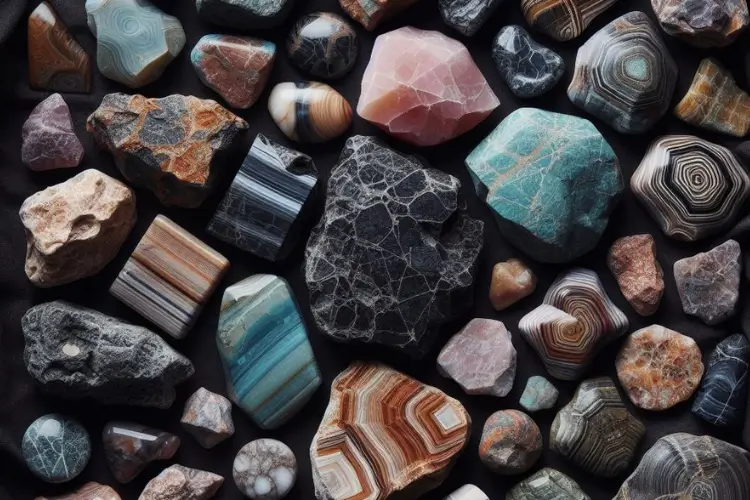Micas have the most platy, parallel, mineral grains with extensive visual aspects of the foliated metamorphic rocks. It is due to the way these rocks form. Mica shows all the parameters of foliated metamorphic rocks because it forms under high pressure.
Rocks that form under high-pressure force the minerals to distribute in the Y-plane. It leads to the formation of mineral layers in the platy form.
What Is a Platy Mineral?
The minerals that form thin layers of the crystals to create many sheets are known as platy minerals.
Most experts call them the leaf-like layers as there are capillary structures inside the mineral layers in the platy structure.
Mica is a suitable platy mineral because it forms under high pressure.
What Are Some Examples of Large Rocks That Can Exhibit Foliated Metamorphic Characteristics?
Some examples of large rocks that can exhibit foliated metamorphic characteristics include slate, schist, and gneiss.
These types of rocks can be challenging to work with but using the proper tools and techniques can help in moving large rocks efficiently.
What Is Platy Rock?
A platy rock forms when you provide rapid heating and cooling to the igneous rocks many times as these rocks will break into a sheet-like structure.
These sheets look similar to the strata of the sedimentary rocks.
What Is Marble’s Parent Rock?
Limestone is the marble’s parent rock.
Marble forms if limestone undergoes a metamorphosis.
It is easy to find the parent rock of the marble because the marble has foliation with a slate-like rock structure.
Many experts believe the limestone had layers of shale before it metamorphosed to form the marble.
Is Schist a High-grade?
Schist is not a high-grade metamorphic rock because experts include it in the class of medium-grade rocks.
Some igneous rocks combine with the mudstone by metamorphosis to form the schist.
Schist forms at a higher temperature than the slate as there is a need for a higher pressure for the schist formation.
What Minerals Makeup Shist?
You can find most platy minerals in the schist.
Muscovite, chlorite, talc, biotite, and graphite are some examples of the abundant minerals in the schist.
Most other rocks have feldspar and quartz.
These minerals are not abundantly available in the schist.
Gneiss has a higher concentration of feldspar and quartz as it forms under higher temperature and pressure than the schist.
What’s the Parent Rock of Slate?
Slate has many parent rocks because a low-grade metamorphic environment produces this rock.
You can find evidence of mudstone, siltstone, and shale in slate.
All of these can be the parent rocks for the slate.
A low-grade environment means the slate forms at a lower temperature and pressure than the schist.
What Is Phyllite Parent Rock?
Phylite forms when the shale and the mudstone undergo metamorphosis.
Both of these can act as the parent rocks for the phyllite.
Phylite is also a low-grade metamorphic rock.
It forms at a lower temperature and pressure.
The convergent plate boundaries are the perfect places for phyllite formation.
These areas have enough pressure and temperature to merge different rocks and change their crystal structure.
Where Is Schist Most Commonly Found?
People used the schist to decorate the walls in the past because of the abundant supply.
You can get it from different parts of the world.
Brazil and Ireland are famous for their schist deposits.
Some areas of the US also have schist deposits.
Small deposits are available on all continents.
What Platy Minerals Often Define the Foliation of a Metamorphic Rock?
Micas and chlorites are the platy minerals that often define the foliation of metamorphic rock.
Foliation forms due to the physical rotation of micas and chlorites.
These minerals migrate in the form of layers in the low-grade metamorphic environment.
The parallel orientation is due to the pressure on the minerals.
What Metamorphic Rocks Have Mineral Grains that Line up in Parallel Layers?
Foliated metamorphic rocks have mineral grains that line up in parallel layers.
There are two types of metamorphic rocks.
The non-foliated rocks do not have sheet-like mineral layers.
You will not see the foliation in these rocks.
When the minerals arrange in the form of parallel layers, they form foliation.
Metamorphic rocks have true foliation because the minerals arrange in the form of layers.
You will not see the foliation in igneous rocks because they form when rocks melt.
“Which Low-Grade Metamorphic Rock, Composed of Extremely Fine-Sized Mica and Other Mineral Grains, Typically Exhibits Well-Developed Rock Cleavage?”
Slate is a low-grade metamorphic rock composed of extremely fine-sized mica and other mineral grains.
It typically exhibits well-developed rock cleavage. Slate has high durability due to the fine-sized mica and fine-grain layer formation.
It forms due to the compression of many mineral sediments.
Is a Strong Parallel Alignment of Different Mineral Bands in a Metamorphic Rock?
Strong parallel alignment of different minerals produces bands in the metamorphic rocks.
Rocks with these bands are known as foliated rocks.
It is easy to identify these rocks due to the different color bands in the rock structure.

